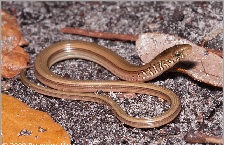Eastern Slender Glass Lizard (O. a. longicaudus)
Description: 8 - 43 in (46 - 108 cm). Glass lizards are long, slender, legless lizards that superficially resemble snakes. They differ from snakes, though, in that they have moveable eyelids, external ear openings, and inflexible jaws. The eastern glass lizard is generally light brown or yellowish to greenish in coloration. This species is best distinguished from other glass lizards by the absence of a dark dorsal stripe or dark markings below the lateral groove and the presence of several vertical whitish bars just behind the head. Older individuals are less boldly patterned than younger individuals, often developing a greenish or speckled coloration.
Habitat: Although these lizards may be found in a variety of habitats they are most common in flatwoods and around wetlands in sandy habitats. Additionally, eastern glass lizards are very common in coastal dune habitats
Range: Eastern glass lizards are found throughout the southern and eastern portions of Georgia and South Carolina but are most common in sandy areas of the Coastal Plain.
Diet: A variety of insects and other invertebrates; they also eat other lizards and the eggs of ground-nesting birds.
Reproduction: From April to October, this species is active during the day as long as temperatures are between 50 and 90 F. Mating occurs in May, and females produce 5–17 eggs in June and July, laying them in a rotten log or under a rock. The mother remains with them until they hatch. There is only one clutch per season. Young take 3–4 years to reach adulthood.
Status: Although not endangered overall in the United States, it is listed as vulnerable in Iowa and endangered in Wisconsin. O. attenuatus is regarded as vulnerable in Iowa, where it is illegal to even capture them. Its primary threats are loss of habitat, and the fragmentation of what remains, by human development. Insecticides are harmful to the lizard because they can kill the insects that they consume and those insects can be ingested by the lizard.
»» Kingdom: Animalia - Animals
»» Phylum: Chordata - Chordates
»» Subphylum: Vertebrata - Vertebrates
»» Class: Reptilia - Reptiles
»» Order: Squamata - Lizards
»» Family: Anguidae - New World Lizards
»» Genus: Ophisaurus
»» Species: Ophisaurus attenuatus - Slender Glass Lizard
»» Subspecies: Ophisaurus attenuatus longicaudus - Eastern Slender Glass Lizard
This article uses material from the Wikipedia article "Slender Glass Lizard", which is released under the Creative Commons Attribution-Share-Alike License 3.0. Content may have been omitted from the original, but no content has been changed or extended.
|





